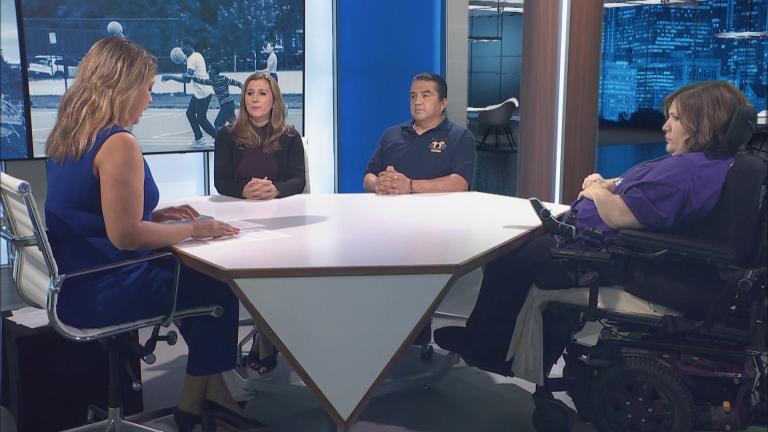 (Michael Izquierdo / WTTW News)
(Michael Izquierdo / WTTW News)
When the FBI retired the old system local police departments use to report crime, low reporting rates plagued the new federal crime database.
Like their counterparts across the country, agencies in Illinois were slow to make the switch. This year, the Chicago Police Department bucked that trend, and experts are cautiously optimistic the improved response rate, which comes with an expanded level of usable information, will continue to increase for other agencies that still remain absent.
That’s good news not just for those in law enforcement and governmental agencies, but also for a whole host of organizations that rely on timely and detailed crime information. While there is some positive momentum, those who work on issues of crime say delays in adoption can have a very real impact on programs aiming to accurately target areas most in need of services.
The National Incident Based Reporting System, known as NIBRS, replaced the old Uniform Crime Reporting Program in 2021 as the federal government’s most visible measure of crime. The old system only reported summary crime statistics, or how many crimes of each type occurred.
In contrast, NIBRS, which was originally approved by the Federal Bureau of Investigation in 1988, allows all crimes charged in a case to be reported rather than just the top charge. It also includes dates, times, days of the week, relationships and demographic details of all individuals involved in a criminal incident, as well as a wider range of charges.
“It's really rich information,” said Janet Lauritsen, professor emerita in the Department of Criminology and Criminal Justice at the University of Missouri St. Louis. “Previously, we just could tell you how many burglaries, robberies, aggravated assaults occurred using this hierarchy rule. And the thought is that kind of richness leads to a more informed understanding about the nature of what's going on.”
The nuanced data is valuable to state agencies making budget decisions, but also is used by citizens, researchers, advocates and nonprofit organizations targeting specific issues, Lauritsen said.
For example, cities can share information with other cities about how they solved a troubling crime problem, Lauritsen said. Victim services agencies and other groups outside the criminal justice system can also benefit from these figures.
The federal government does not enforce violations against local departments for non- participation in the system, and state government agencies have limited authority to consider withholding some grant funding.
Compliance in Illinois
Locally, the Chicago Police Department made a report each month of 2022, and the months at the beginning of 2023, according to a database from the Illinois State Police. The full year’s account in 2022 made Chicago the largest municipal department in the nation to report such data, according to a recent story from the Marshall Project.
A statement from the department said it began submitting NIBRS data to the state in July 2021, following a transition in reporting systems. The city received a $500,000 federal grant to help implement its NIBRS reporting system.
While Chicago is up and running, CPD is a great deal larger than most local departments in the state. The obstacles to full reporting vary for different sized departments.
Other large Illinois municipalities reporting data to NIBRS through the Illinois State Police system in 2022 include Naperville and Elgin, according to the ISP site and local officials. However Aurora, the state’s second largest community, and Waukegan, 10th largest, only reported one month of data in 2022.
Aurora Public Information Officer Joseph Howe wrote in a statement, “We have been working with our Records Management System (RMS) vendor to implement our NIBRS reporting tool, but unfortunately, this was not ready to be certified by the state at the end of 2022.”
Howe said the department will be able to submit data once its reporting tool is certified.
A Waukegan deputy chief said the department wasn’t required to report data last year, and that it took about a year to upgrade computers to become fully NIBRS compliant. He said the department is currently compliant and will be making regular reports in the future.
According to an Illinois State Police spokesperson, there are currently 600 agencies in the state certified to report to the NIBRS Repository, and 60 agencies actively certifying. Historically, approximately 700 agencies participated in the older UCR data program.
All data submitted to the NIBRS program isn’t automatically accepted by the FBI, meaning actual reporting rates can be lower than what is reported by the state.
Small departments in Illinois were more likely to report no data to NIBRS, according to Illinois State Police data. Only six of 58 agencies reporting no data to ISP last year had populations larger than 10,000. Most were under 5,000 with many in the hundreds.
Reasons for Delay
David Olson, criminology and criminal justice professor at Loyola University Chicago, said some local departments don’t have time or resources to spend on the NIBRS process, and some may not trust it. Community members may pressure departments to have other priorities than improving their crime data, he said.
Illinois has the third highest number of state and local police agencies in the country, according to a recent report from the Bureau of Justice Statistics. The number is even larger than that estimate, according to ISP, because there are also many regional task forces, park district, university and transportation-related police departments operating in the state.
This could present a problem for Illinois compared to other states getting all departments to report NIBRS data, Olson said, because “it’s a lot easier to get 50 people on board than 850.”
Training is a key factor. A department can’t just snap its fingers and expect its entire staff to understand all the reporting requirements of NIBRS. Most departments aim to train their full staff, while smaller staffs sometimes hire a specialist to assist with data entry.
Niles Police Chief Luis Tigera said the process is more resource-intensive, and his department can improve efficiency with internal training.
The technical capacity of police departments to handle the larger data files required to report to NIBRS can also be an obstacle to compliance. Some departments’ records management systems would need to be upgraded to participate in NIBRS, according to an Illinois State Police spokesperson.
Early in the transition process from the older system to NIBRS, departments struggled with the potential problem of having to explain an apparent rise in crimes to the people in their community that was simply a more detailed accounting of crime, Lauritsen said.
When the system finally moved to NIBRS last year, the federal government knew it would be a difficult transition, Lauritsen said. Federal grants to assist with the transition were made available, Lauritsen said, but some departments resisted because of the cost, time or resources involved in the move.
The gaps in data from last year have had real consequences for programs in Illinois, Olson said. Take the Office of Firearm Violence Prevention as an example. The office was created in 2021, and has a $250 million budget to solve issues connected to gun crime in Chicago community areas and other municipalities with the highest rates of firearm victimization.
While the state now has an approved NIBRS program, it did not at the time the law was passed. Most gun crimes don’t involve injuries, Olson said.
“If you wanted to focus resources on where there is the biggest problem with gun violence, you would be limited to only relying on fatalities and emergency room admissions to understand that problem,” Olson said.
When the program was launched, documents show the research group agreed there was “no single publicly available statewide data source that meets the requirements of the Act” that created it.
This fiscal year, the program spent $25 million on violence prevention providers in Cook County, and more than $12 million on the Flat Lining Violence Inspires Peace (FLIP) program in impacted communities, which leverages the influence of community residents to mediate conflict, minimize arrests and victimization, and offer retention incentives to peacekeepers.
The state previously tried to roll out its NIBRS program all the way back in 1992, according to a report from the Illinois Criminal Justice Information Authority. The system experienced significant data collection difficulties for both the participating agencies and Illinois State Police, stemming from complexities associated with the expanded reporting requirements.
By the end of 1994, Illinois State Police suspended the collection of NIBRS data, according to the report.
Decades later, the program is finally in place, even if the participation level is below what it was in the old system. Though more agencies will make the transition, there will always be holdouts.
“The thing is, they argue, that we know our community. We don’t need these numbers to tell us where to increase in our patrols,” Olson said. “Some of it can also just be the view that the data doesn't really provide you with better information than professional experience.”
Contact Jared Rutecki: @JaredRutecki | [email protected]








